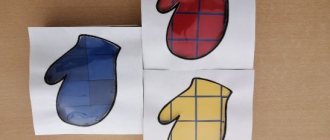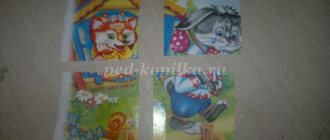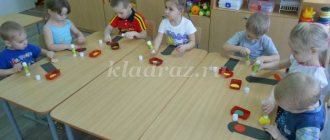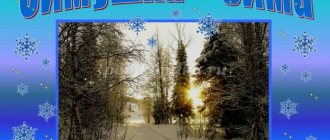Lesson summary for junior group 2 on the topic: Winter
Lesson summary for the junior group “Winter has come to visit us”
Author:
Anastasia Sergeevna Burachevskaya, teacher at MBOU “Shegarskaya Secondary School No. 1” p.
Melnikovo, Tomsk region. Description of the material
: I offer you a summary of direct educational activities for children of the second younger group (3-4 years old) on the topic: “Winter”.
This material will be useful to teachers of the younger group. This is a summary of an integrated lesson aimed at consolidating children's knowledge about seasonal changes. Integration of educational areas: “Cognitive development” (formation of a holistic picture of the world), “Social and communicative development”, “Artistic and aesthetic development” (drawing), “Physical development”. Goal: Continue to form ideas about the seasons (winter). Objectives: Educational
: learn to create a simple plot picture by completing an adult’s drawing, learn to name the main signs of the winter period, consolidate vocabulary on the topic “Winter”, “Clothing”.
Developmental
: develop correct physiological breathing, develop interest in dance creativity.
Educational:
cultivate curiosity, activity, independence, respect for a peer’s answer.
Materials and equipment: paintings about winter, paintings with a doll in winter and summer (autumn) clothes, paper snowflakes (for each child), tape recorder, wet wipes, oilcloths, white gouache, plates, winter tree preparation. Methodological techniques: conversation - dialogue, looking at illustrations and talking about them, physical education, active play with elements of a musical lesson, productive activity of children, reflection.
GCD move:
The lesson begins with the gymnastics “Gift under the Christmas tree”.
Goal: relax children before class and get ready for work. “A gift under the tree”
“Imagine that the New Year holiday is coming soon.
You've been dreaming about a wonderful gift for a whole year. So you approach the Christmas tree, close your eyes tightly and take a deep breath. Hold your breath. What lies under the tree? Now exhale and open your eyes. Oh, miracle! The long-awaited toy is in front of you! You are happy? Smile." Educator: Guys, look carefully at the pictures. What time of year are they depicted? (Winter) How did you guess? (There is a lot of snow on the trees and ground, children are making a snowman, people are dressed warmly) Is it winter here now? (Yes) What is there a lot of in winter? (Snow) What is he like? (White, cold, fluffy, prickly) And snow is small snowflakes. Let's turn into snowflakes. The teacher reads the text, shows the movements, and the children repeat. Snow, snowball spinning - Performing the “flashlight” movement with your hands. The whole street is white. – Swing your lowered arms to the right – to the left. We also gathered in a circle - Walking in a round dance. They spun around like snowballs. — Children dance to the music “Waltz of Snowflakes.” Educator: We made such beautiful snowflakes. Guys, I still have snowflakes. Let's make it snow with you. The teacher hands out snowflakes to each child and asks them to blow on them so that they also spin.
Educator: It’s snowing and cold outside now. What will you and I wear if we go for a walk outside? (Children's answers) Educator : Look, our dolls also want to go for a walk. Look carefully and tell me which one of them can go for a walk in winter. What is she wearing? (Children's answers) That's right, the doll that is dressed warmer can go for a walk in winter. Educator: Guys, let’s draw a snowball now. Go to the tables. But before we start drawing, we need to do exercises for our fingers. One, two, three, four, five - we bend our fingers one by one. We came to the yard for a walk. - We walk along the table with our index and middle fingers. We sculpted a snowy woman, - we sculpt a lump with two palms. We fed the birds with crumbs, - crumbling movements with all our fingers. We then rolled around with the forefinger of our right hand. And we also rolled in the snow. – We place our palms on the table, first on one side, then on the other. Everyone came home covered in snow. – Shake off our palms. We ate the soup and went to bed.
– Movement with an imaginary spoon. Hands under the cheeks Children begin to draw snow - with their fingers, on pre-prepared sheets with a picture of a tree. The teacher helps children in difficulty while working. After completion, everyone looks at the resulting paintings together.
In the morning there is thin ice on the puddles.
The first snowball is spinning in the air. Light fluff winds along the street. Children admire: How good! V. Kalinkin Reflection: - Guys, what time of year were we talking about today? — What do you remember about winter? — How did we draw snowfall?
We recommend watching:
Notes on sensory development in the junior group on the topic: Winter Notes on a lesson on cognitive development in the 2nd junior group on the topic: Winter Notes on educational activities in the junior group. Journey to the winter forest Synopsis of GCD in the 2nd junior group. Snow falls
Similar articles:
Summary of a game lesson for young children on the topic: Winter
Summary of a math lesson in the second junior group on the topic “Winter has come”
Summary of a mathematics lesson in the second junior group on the topic “Winter has come”
Purpose: - to teach to distinguish between the concepts of “one” and “many”, to consolidate children’s knowledge about geometric shapes. — Fix primary colors. — Enrich the vocabulary (one, many, identical, circle, square, triangle). — Develop visual attention, speech, motor skills, fine motor skills, coordination of movements, independence. Materials and equipment: Pictures depicting winter fun, a box with mittens cut out of colored cardboard (with patches of geometric shapes).
Geometric shapes cut from paper. Progress of the lesson:
We sit down at the tables.
The lesson begins with a poem: Winter has come - it’s white again.
It's fresh outside again. The snow is like cotton wool. There's a lot of it. I want to touch it with my hand. I also want to throw snowballs and play with friends in the yard! Educator: Guys, is it winter outside? Look out the window, how much snow there is! What can you make from snow? Children's answers. Educator: Correct! You can sculpt a snowman out of snow, make a slide, sled, skate, and of course play snowballs! Show pictures of winter fun - comment on all the images with the children. Educator: Guys, it is very cold in winter, and before playing in the yard, in an area with snow, it is necessary to protect our hands. Having guessed the riddle, you will immediately understand what will help us not freeze in winter: They gave the brothers a warm house so that the five of them could live. The big brother did not agree and settled separately. What is this? Children's answers: mittens, mittens. Educator: Let's see if we answered correctly (open the box)
.
Let's see what's in it? (we take mittens out of the box)
.
What is this? Children's answers. Educator: Correct! These are mittens
.
They are the ones who protect our hands from the cold. Guys, tell me how many mittens we have in the box? Children's answers: (many)
.
Educator: What color are they? Children's answers: they are different colors, red, blue, yellow, green. Educator: That's right, the mittens are different colors. Take one mitten at a time. Choose the one you like. Children take one mitten each. Educator: (address 4-5 children one by one, encouraging them to give a complete answer to the question)
.
How many mittens do you have? What color is your mitten? Educator: Guys, look, there are patches on our mittens. What shapes are the patches made of? Children take turns naming geometric shapes (circles, squares, triangles, which are depicted on the mittens)
.
Educator: Guys, I suggest you choose the right patches for your mitten in color and shape. We take the patches and apply them to our mittens (you need to choose the right shape and color)
.
And now, everyone finds a pair for their mittens, they should be the same color and with the same patches. Children choose a pair for their mitten. Educator: Look, everyone got a pair. We ask 2-3 children what kind of mittens you have (the answer is, for example, blue, with yellow triangular patches)
.
So what are they like for you? Children's answers: The same. Now we lay out our mittens on the table. Guys, how many mittens did you make? Children's answers: a lot. Teacher: (takes one mitten)
I have a green mitten with round and triangular patches.
Help me find the same one. Children help the teacher complete the task. Educator: Well done! I have two green mittens. (Shows) Educator: Guys, now help me pick out patches for my mittens. Which shapes should I choose? Children's answers: circle, triangle. Educator: Look what beautiful mittens with patches we have made. Now our hands won't be cold in winter! Gymnastics will also help warm up our hands and fingers! Finger gymnastics “Mitten” Knitted by Grandma Fox Mittens for all the little foxes: (Rub the pads of the remaining fingers with your thumb one at a time.)
For the little fox Sasha, For the little fox Masha, For the little fox Kolya, For the little fox Olya, And small mittens For Natasha the little fox.
Educator: Now our hands won’t freeze! And everyone now has their own pair of mittens! Children carefully place their mittens in a box.
We recommend watching:
Summary of lessons on FEMP in kindergarten. Second junior group. Triangle Notes for a math lesson in the second junior group. The quantity is as much as Notes for a math lesson in the second junior group. Comparison of objects by width Summary of a lesson on FEMP in the second junior group. Geometric shapes and their properties
Similar articles:
Summary of a lesson on FEMP in kindergarten in the second junior group. Topic: “Circle, square”
Math lesson notes. Topic: “Equality of objects.” Second junior group
Planning classes on FEMP in the second junior group according to the Federal State Educational Standard for a year
Lesson notes on FEMP in the second junior group. January
Lesson notes on FEMP in the second junior group for February
Lesson notes for the second junior group. Topic: “Winter and winter activities.”
Transcript
1 MBDOU d/s "Romashka" s. Terbuny Lesson notes in the second junior group. Topic: “Winter and winter activities.” Educator: Belokopytova L. N. 2016
2 Objectives: - Expand children’s knowledge about the season - winter. — Reinforce the concept that winter activities are typical only for winter. -Learn to guess riddle poems. — Activate children’s speech through artistic expression. - Continue to learn how to answer questions. -Develop visual and auditory perception, attention, logical thinking, coherent speech. — Cultivate auditory concentration and emotional responsiveness to music. Educational areas: social and communicative development, cognitive development, speech development; artistic and aesthetic development, physical development. Materials and equipment: Multimedia installation, presentation “Winter. Winter fun”, audio recording “Sounds of a Blizzard”, “Dance of Snowflakes”, tape recorder, snowflakes according to the number of children, a large snowflake, handouts according to the number of children for modeling snowmen. Progress of the lesson. Org. Moment. The audio recording “Sounds of a Blizzard” plays. - Guys, do you hear these sounds too? What could it be? It seems like it’s a blizzard, I need to close the door as soon as possible (I head towards the door and find a snowflake outside the threshold). -Look, Snowflake has come to visit us. It is not simple, but magical. Snowflake wants to tell you a riddle, listen carefully: “In the clearing, in the meadow, a snowball is quietly falling! The snowflakes and white fluffs have settled down! Everything is white all around, There’s a lot of snow!” - When does this happen? (In winter) - What words can you use to describe winter? It's cold in winter. So what kind of winter is it? (Cold). - There is a lot of snow in the winter. So, what kind of winter is it (Snowy).
3 - If there are frosts in winter, then winter is (Frosty). — What is the name of this phenomenon when many, many snowflakes fall to the ground? (snowfall). - And now Snowflake offers to play the game “Winter Words.” To make it more convenient to play, let's stand in a circle. I will name words, if you hear words related to winter, then clap your hands. Snowflake, warmth, sled, ice, heat, mittens, chamomile, slide, New Year, snowman, falling leaves, Santa Claus, apples, Snow Maiden, sunbathing, snowfall, skis, skates, frost. “You were very attentive and completed the task.” And the snowflake has another surprise for you. Let's sit on the chairs and find out what she has prepared for us (children sit in front of the multimedia installation). - Guys, our old friend Luntik has never seen snow. And then one day he woke up and saw a cartoon about Luntik “First Snow”). As we watch, I ask the children questions: “Guys, what kind of winter clothes do you know?” (children list) Look at the picture (slide 2) and tell me which of these things can be worn for a walk in winter? — Even though it’s cold outside in winter, you can come up with many different games and fun. Let's go and play. Physical exercise. It's frosty and windy outside, Children are walking in the yard. Hands, hands warm, Hands, hands rub. So that our feet don’t get cold, We stomp a little. We are not afraid of frost,
4 This is how we will dance now. In winter we play snowballs, We walk through the snowdrifts, And we run on skis, We fly on ice skates. - We are not afraid of any frost, wind, snow, because from a fun game we have good, strong health. — You and I already know that if you dress warmly, you can walk outside in winter. What winter fun do you know? What can you do outside in winter? (play snowballs, make a snowman, skate, ski, sled, etc.). — The snowflake has the following riddle: “I was not raised, I was blinded from snow. Instead of a nose, they cleverly inserted a carrot. Eyes are coals, Hands are bitches." - Who is this? (snowman) Slide 3 Attention game “Compare the snowmen.” - Look carefully at the pictures, compare the snowmen and tell me how they differ from each other? (children answer: one snowman has a bucket on his head, the other has a hat, etc.) Laying out a snowman - Snowflake invites you to the workshop, where you can also make snowmen, only from paper. — You have parts of snowmen in your bins, try to make your own snowman out of them. — Let’s start making a snowman on a blue piece of paper, and I’ll read you a poem. “Since the very morning, the children have been making snowmen, rolling snow globes and, laughing, connecting them. Below is the largest lump, Slightly smaller lump on it
5 The head is even smaller, they barely reached it. The eyes are coals, and the nose is a carrot. They put the hat on deftly. A bright scarf, a broom in hand, and the kids are happy.” - What beautiful snowmen you made. Snowflake really enjoyed visiting us, and did you enjoy playing with Snowflake? What did you like most? What else were we doing? Unfortunately, it's time for Snowflake to fly away.
Junior group. Early childhood, nursery. Children 1-4 years old
Lesson summary on the topic “How the kitten was surprised at winter” for children 3–4 years old Topic: “How the kitten was surprised at winter”
Goal: To teach children to describe natural phenomena. Objectives: Educational: To promote the formation of the ability to correlate a word with the action that it means. To reinforce children’s concepts about various natural phenomena. Activate pronunciation...
Summary of the lesson “Winter-winter” in the early age group
Summary of a lesson in an early age group from 1.6 to 4 years old on the topic “Winter - winter ”
Goal: expanding children's knowledge about
winter natural phenomena . Objectives: Educational: Learn to guess poems - riddles; To consolidate children's knowledge about the characteristic signs of winter; Form a concept about...
Summary of the lesson “Winter” in the second junior group.
Summary of the lesson “Winter” in the second junior group.
Lesson objectives
: consolidate children’s knowledge about the seasons - winter. Teach children to guess riddle poems about winter.
Tasks:
1) consolidate vocabulary on the topic “ Winter ”
2) activate and enrich vocabulary:
winter
, snow, snowflake, sled, skates, skis, snowman, sculpt, cold, snowy, frosty, etc.
3) develop visual perception, attention, thinking, imagination, observation.
4) cultivate a love for the winter season
Equipment: subject painting “ Winter ”
, a basin with a small amount of snow
Progress of the lesson.
Guys, listen carefully to the poem and finish the word:
The roof is covered with fur,
White smoke overhead.
Yard in the snow. White at home.
( Winter ) came to us
Guys, what time of year is it now? ( Winter )
.
Why do you think it's winter
? (children’s answers: it’s cold outside, it’s snowing, a cold wind is blowing, a snowstorm….)
I show you a picture of a winter landscape. Winter
- the most majestic period in the development of nature. Listen to how beautifully the poet A. S. Pushkin calls winter in his poem:
... Now the north, catching up with clouds, breathed and howled -
And here comes the sorceress winter
!
December, January and February are the three months of winter in our harsh climate. So we can say that winter is cold
, snowy, frosty.
A white veil covered the earth. What do you think is the white veil that covered the earth? (Snow)
What kind of snow is there? (White, fluffy, sparkling, sparkling, shiny, cold, soft, etc.).
Snow, when it covers streets, houses, trees, looks like a carpet, blanket, hat, etc. We don’t have snow in the group
, that's why I brought it to you from the street.
(basin with a small amount of snow)
.
Let's see what happens to it after a while (it melted)
. Why do you think the snow melted?
You will find out what snow is made of by solving the riddle:
A white star fell from the sky, landed on my palm, and disappeared. (Snowflake)
. What kind of stars is this riddle talking about?
That's right, about snowflakes. After all, a snowflake is shaped like a star. And snow consists of snowflakes. Snowflakes, like fluff, fly and swirl in the air. There are so many of them that they covered the entire earth. Snow covers the ground and tree roots with a white blanket to keep them warm
Now you and I will turn into fluffy snowflakes for a few minutes. Let's imagine that we are flying, spinning like snowflakes. (Children spin around, make smooth movements with their hands, stand in a circle)
In winter, outside you can come up with many different games, fun and entertainment for children and adults.
1 Two birch stakes carry me through the forest
These horses are red, and their names are... (skis)
2 I rush forward like a bullet, Only the ice creaks,
Let the lights flicker! Who carries me (skates)
3. I took two oak bars, two iron strips,
I filled the bars with slats, Give me snow! Ready... (sleigh)
.
Guys, in winter you can go skiing, sledding, and skating. What other games and entertainment do you know in winter? ( Children's : sculpt a snowman, play snowballs, etc.)
Tell us, what games and interesting entertainments did you play outside in winter? What was your mood when you played games? (Good, cheerful, pleasant, joyful)
. This is how much fun it is to take a walk in winter. You can always play an interesting game or entertainment.
New Year comes in winter. Father Frost and Snow Maiden come to the holiday, they dress up and decorate beautiful Christmas trees. Let's play with you a little.
Physical school
.
Little children have a big Christmas tree.
The Christmas tree sparkles with lights and balls.
Oh yes, Christmas tree, look, look (children clap their hands)
.
Children, Christmas tree, light it up, light it up. (Children raise their arms above their heads and turn their palms to the right and left)
Don’t stab us, little Christmas tree, with a shaggy twig (they threaten with a finger,
Keep the needles away from the kids longer.
Guys, let's make a story with you about winter (they talk about winter)
. I really liked your answers. Well done boys.
Lesson summary
:
What time of year were we talking about today? And winter
, which? What games and entertainment can you play in winter?




